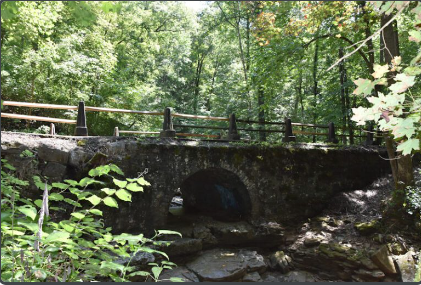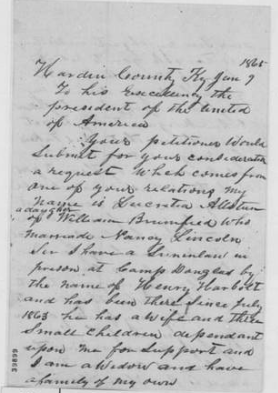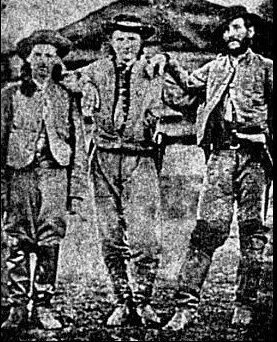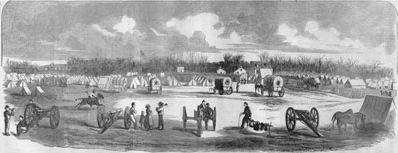
Northern Hardin County
WEST POINT
By the fall of 1861, Federal infantry establishes a base camp at town. While serving in the Department of the Cumberland, Brigadier Generals Robert Anderson and General Wm. T. Sherman were briefly headquartered there. In September 1862 thousands of Buell’s Army of the Ohio stop in and pass through town on their way to Louisville. In 1864 and 1865, the town is plagued by numerous guerrilla attacks.


FORT DUFFIELD
Soldiers from the 9th Michigan and 37th Indiana constructed this earthen fortification beginning in November 1861. Soldiers built their own quarters to keep warm during the winter. After the spring of 1862 the fort was used sporadically. In 1864 guerrillas burned the remaining quarters around the fort. Fort Knox gave the historic fort to the town of West Point in 1978 and it is now open to the public as a community park and is listed on the National Register of Historic Places. A number of soldiers died and were buried while stationed there. A memorial cemetery is located near the fortification.

LOUISVILLE & NASHVILLE TURNPIKE
During the time of the Civil War the military of both sides were known to use the L & N Turnpike. A portion of published tollgate record books kept by George Fisher shows the presence of Union activity on Fort Knox’s section of the turnpike in the early years of the war. Union troops of Buell’s Army of the Ohio moved through the area along the turnpike in September 1862. Fort Knox has a section of the turnpike, called “Bridges to the Past,” open to the public.

BLOOMINGTON (Fort Knox)
Bloomington, later know as New Stithton, was located on present day Fort Knox. In late September 1862, Buell’s Army of the Ohio takes 2 ½ days to pass through the small village. In a September 30th article from the Cincinnati Daily Commercial, a reporter noted the numbers of Soldiers marching, “And now commenced the living stream that flowed incessantly by for two days and half. In cities, people think a regiment of soldiers interminable, but what would the citizens of Cincinnati say, to more than ten miles of soldiers, on the march-infantry, artillery, and cavalry-filling past, regiment after regiment.” Local farmer Milton Stith “was deprived of all his cattle, sheep and corn” by the soldiers and was issued Quartermaster receipts for payment. His postwar claims for compensation from the government failed. Stith is buried in a Tarpley Cemetery at Fort Knox.

Located in present day Radcliff, Kentucky. Buell’s Army of the Ohio would have passed near here during 1862 and it is believed Morgan passed through this area during his July 1863 raid. At the entrance to the park is the renovated Atcher Cabin, which belonged to Civil War veteran Edward Atcher, 4th Kentucky Mounted Volunteer Infantry (USA).
RED HILL
Lucretia Allstun (1824-1886), Lincoln’s cousin writes him from here asking for the release of her son-in-law, Henry Harbolt, who was captured while riding in the Confederate service. Lucretia Allstun is buried in Bogard Cemetery at Fort Knox. The Red Hill area is now in the Radcliff vicinity.

Lucretia Allstun to Abraham Lincoln, Monday, January 09, 1865 (Requests release of prisoner)

MILL CREEK
Abraham Lincoln’s grandmother, Bathsheba, along with her son Thomas (the president’s father) and her youngest daughter Nancy Ann with her husband William Brumfield moved to this area from Washington County, Kentucky. Bathsheba and other relatives of Lincoln are buried in Lincoln Memorial Cemetery. Guerrilla and rouge military activities were noted in the area. Area is located on present day Fort Knox.
FORT KNOX
During the Civil War the military installation of Fort Knox did not exist. At that time the land was occupied by citizens living in numerous small towns and villages that supplied men to both armies. Union and Confederate armies passed through and occupied the area at various times and both used the Louisville and Nashville Turnpike as a main thoroughfare through this country. A portion of this turnpike runs through Fort Knox. No major battles were fought in this area; however, the area was plagued by attacks and depredations by guerrillas. Numerous Civil War veterans are buried in Fort Knox’s 120 cemeteries.

Western Hardin County
BIG SPRING
Between 1861 and 1865, the town of Big Spring was home and hiding place for several Guerrillas including Marcellus Jerome Clark, also known as “Sue Mundy.” On March 12, 1865, 20-year-old Mundy was captured a few miles from Irvington and was brought here and temporarily held under guard in the cellar of the General Store. The next day he was taken to Brandenburg where he boarded a riverboat and was transported to Louisville where he was tried, convicted and hanged on March 15, 1865 for guerrilla activities.
On January 5, 1865, a detachment of 191 members of the 12th USC Heavy Artillery, under Sgt. Elijah P. Marrs, camped on the outskirts of Big Spring. After entering town to ascertain Confederate location, the detachment was fired upon and escaped the town with one casualty. This was the largest engagement that the 12th USC Heavy Artillery was involved with during the war. Following the engagement, the 12th returned to Elizabethtown leaving Big Spring in guerrilla hands. The 12th USC Heavy Artillery was organized at Jessamine County, Kentucky’s Camp Nelson on December 1, 1864. They continued service until April of 1866. A total of 21 members of the Colored Troops died while in the county from either disease or raiding guerrillas roaming the area. Most graves were moved from the county to Cave Hill National Cemetery in Louisville, Kentucky in 1868.
A History of Marcellus Jerome Clarke (“Sue Mundy”)


STRICKLER PLACE
Two miles to the west of Elizabethtown overlooking Valley Creek on the site of the 1790s VanMeter Fort was the “Strickler Place.” Mrs. Ellen Johnson Strickler, the second wife of George Washington Stickler, Sr., who was known to be an excellent cook and hostess and occasionally boarded guests in the area was forced to entertain the notorious John Hunt Morgan and quarter his body guard in her home while his troops, 2,000 strong in number, made their self home in her yard on October 20, 1862. Before taking leave of Mrs. Stickler’s home the group burned the two hundred foot long L & N railroad bridge rising ten feet over the waters of Valley Creek, confiscated four horses, one mule, all her corn and poultry as well as burning available wood while keeping fires all around the yard. Many of the area citizens were taken advantage of by guerrilla forces during the duration of the war.
The County Seat-Elizabethtown
THE BATTLE OF ELIZABETHTOWN
On December 22, 1862 Confederate General John Hunt Morgan left Tennessee on his Second Raid into Kentucky, often called his “Christmas Raid.” On December 27, with nearly 4000 men, Morgan stopped at Elizabethtown. Six Hundred Union soldiers belonging to the 91st Illinois Infantry occupied the town and forced Morgan to fight for it, street-by-street, building-by-building, for several hours. Finally Morgan’s numbers and artillery took their toll on the town and its occupants, forcing surrender of Lieutenant Colonel Harry S. Smith’s command. At least seven Union soldiers were killed during the engagement. After paroling the soldiers, Morgan’s force left to destroy for two railroad trestles north of town.
CAMP HAYCRAFT
Located on the south east of Elizabethtown on the hill that once occupied a 1790s pioneer fort. The encampment was home to the 18th Ohio, 19th Illinois, 9th Michigan, 37th Indiana, 124th Ohio, and several Kentucky troops who guarded the bridges and drilled for service. Thirteen soldiers from the 9th Michigan died while stationed at this camp. Some deaths were attributed to Typhoid Fever. A total of 26 graves were removed to Cave Hill National Cemetery from this camp following the war.
CAMP WASHINGTON
This was a temporary Federal encampment located at Helm Place, home of Kentucky Governor John LaRue Helm, one mile to the north of Elizabethtown along the L & N Turnpike. During December 1861 there were 10,000 men at this camp, named for the father of the country, before they were moved to Bacon Creek, now known as Bonnieville.
PROMINENT ELIZABETHTOWN CITIZENS ARRESTED
During the war local citizens of strong Southern sympathies were imprisoned by military authorities. Four of Elizabethtown’s prominent citizens were imprisoned much of the time at the Federal Guardhouse in Louisville, Kentucky for that reason. They were Sanford J. Poston, A.H Cunningham, Governor John LaRue Helm and Alfred M. Brown. On April 15, 1862, a letter printed in the Louisville Journal addressed to Mr. Alfred M. Brown, the Circuit Clerk of Hardin County, openly posed several questions to Brown’s financial and material aid of Rebels, support of the rebellion and use of his considerable powers and office to initiate candidates to the Order of the Knights of the Golden Circle, a secret society promoting the interest of the Confederate Government of the Southern States.
RECRUITMENT OF MEN TO THE CONFEDERATE ARMY
Following the burning of the bridge over the Rolling Fork River near Colesburg in September of 1861,Col. Basil W. Duke (brother-in-law to General John Hunt Morgan) stood at the courthouse lawn and rallied local citizens to take up arms in support of the South. He was interrupted by Federal forces marching into town, which scattered those gathered.
COUNTY CLERK OFFICE RANSACKED
While returning through town after the action at Perryville, Kentucky, General John Hunt Morgan entered the office of the Honorable Samuel Haycraft, Jr. causing disarray of its contents.
HOSPITAL AND CONVALESCENCE CAMP
Dr. Robert Murray, Medical Director for General Don Carlos Buell’s army, established a convalescent camp for 1,000 at Elizabethtown along the L & N Railroad. This proximity to the railroad enabled men to easily rejoin their units when fit for duty. Murray also set up a hospital in the Baptist Church on Poplar Street, one block from the center of town.
Eastern Hardin County
FORT SANDS (Sulfur Fork Trestle)
This earthen fortification was built by Union forces to protect the L&N Railroad trestle that rises 90 ft. above Sulfur Fork. It is believed the fortification had two construction phases. During the first phase, in 1862, a rectangular stockade/blockhouse was constructed southwest of the railroad tracks. This stockade, along with the trestle bridge, was captured and burned by Gen. Morgan on December 28, 1862 after a brief skirmish with 560 Federal troops of the 71st Indiana and the 78th Illinois. After Morgan’s destruction, the second phase of construction occurred using a design from Lt. Miles McAlester. From January through August of 1863, the 50th and 113th Ohio Regiments worked on the earthen fortress and equipped it with artillery to defend the 500 ft. long bridge that was completed by February 1, 1863. The fort was given the name Fort Sands, after Alexander C. Sands who was the U. S. Marshall for the Southern District of Ohio. Union forces safeguarded the railroad for the duration of the war. Seven soldiers died while stationed at Fort Sands. Their graves were removed after the war and taken to Cave Hill Cemetery in Louisville.
FORT BOYLE
This fort, located about one mile south of Colesburg, Kentucky along the L & N Railroad, was built by Union forces in January of 1863 to protect a railroad trestle over big Run that John Hunt Morgan had previously burned on December 28, 1862. The trestle was rebuilt and open by January 23, 1863. The fort was occupied by many different regiments throughout the remainder of the war, including the 50th and 113th Ohio which aided in construction of the fort. The fort was named after General Jeremiah T. Boyle, military Governor of Kentucky. It was reportedly once called Camp Lucy, because the commander had a grudge against some Buckeye lady. Nineteen soldiers died while stationed at this camp.
FORT JONES
This fort was located along the L & N Railroad and built by the 50th Ohio to protect bridgework over the Rolling Fork River. The fort was originally called Fort McAlester. Captain M.D. McAlester was the designer for several forts in the area and the chief engineer for the Corp of Engineers. It probably received its permanent name after Captain Toland Jones, who was the commander of the 113th Ohio that was stationed there. The Rolling Fork bridge was burned on June 19, 1861 by southern sympathizers and again on September 18, 1861 by Major Thomas H. Hays (CSA.) These actions brought about an increase of regiments to guard bridge and trestle works in the area. Guerrillas under the command of Sue Mundy and the Henry Magruder attacked the bridge again on February 18, 1865. Fifteen soldiers died while stationed there and were removed to Cave Hill National Cemetery in Louisville, Kentucky after the close of the war.
CAMP JO DAVIESS
This encampment was located near the Samuel Bush home in the Tunnel Hill community not far from the L & N Railroad tunnel that was guarded by troops from the 38th Indiana and 49th Ohio.
During the morning hours of December 29, 1862, forces under Union Colonel John M. Harland of the 10th Kentucky Infantry attacked General John Hunt Morgan (CSA) at Johnson’s Ferry (Hamilton’s Ford) on the Rolling Fork near Boston. The engagement was short, lasting about an hour and a half. Several Confederates were killed and wounded with only 2 Federals killed and 3 wounded before the Confederates retreated towards Bardstown leaving behind a captured captain and six privates. Confederate Colonel Basil W. Duke was seriously wounded in the exchange of fire. Harland was unable to stop Morgan’s escape from the area, however.
Southern Hardin County
BATTLE OF VINEGAR HILL
September 22, 1862-Following the capture of Munfordville, the rear guard of the Confederate army under General Braxton Bragg was overtaken by an advance guard of Union forces under the command of Major General Don Carlos Buell near the area known as Vinegar Hill. A skirmish ensued with cannon fire between the two armies and ended with several casualties on both sides. Seven Confederates were buried near Dorsey’s Branch and three members of the Union’s 2nd Regiment Indiana Cavalry interred on the farm of J.T. Brawner. Bragg’s Army withdrew through Hodgenville while Buell’s Army pushed onto Elizabethtown and north to Louisville.
CAMP NEVIN
This Union training camp, established at Red Mills (extending to the confluence of 31W and the Nolin River,) numbered 15,000 men from October 1861 through early spring of 1862 before being moved south. The camp was named for David Nevin, secessionist owner of the farm on which part of the encampment occupied. From here Federals units were detailed to guard bridges on the L&N Railroad. Guards also positioned at Red Mills river ford to intercept contraband goods.
Primitive sanitation, overcrowding and poor diet led to “camp disease,” a combination of diarrhea and dysentery. Other contagious diseases such as measles, mumps, smallpox and typhoid caused numerous deaths here. Many were buried at Red Mills Cemetery, now located on the west side of US 31W just north of Nolin River, and were later moved to Cave Hill National Cemetery at Louisville, Kentucky.
FIGHTING AT UPTON
While at Upton, a telegraph operator attached to Confederate General John Hunt Morgan’s staff known as “Lightning” Ellsworth, tapped into the telegraph line and dictated Morgan’s messages to Union General Boyle in Louisville. Under the guise of a local operator, Ellsworth made inquiries as to the disposition of Federal forces in Kentucky and embellished stories in regard to the size of Morgan’s command and movements.
This masquerade enabled the raiders to cause further destruction of the railroad line, culverts and bridgework at Nolin, Kentucky. John Allan Wyeth, a 17-year-old in Morgan’s command, recalled how Upton was taken. “As we struck the railroad at Upton, we saw several Union soldiers walking along the track, each with his gun on his shoulder. Under orders, we spurred our horses rapidly forward.
Captain Tom Quirk, pistol in hand, shouted to them to surrender, at the same time firing over their heads. Before anyone else could shoot, the men threw up their hands.”

Camp Nevin as depicted in the
December 7, 1861 issue of Harper’s Weekly

Nolin Station (click to enlarge)
February 15, 1862 Frank Leslie’s Illustrated Newspaper

Building a military bridge over the Nolin River by
Muller’s Battery Company, 77th Pennsylvania Regiment
February 15, 1862 Frank Leslie’s Illustrated Newspaper







